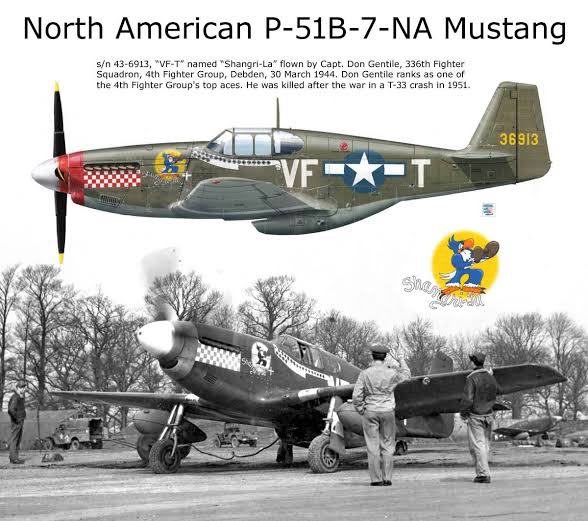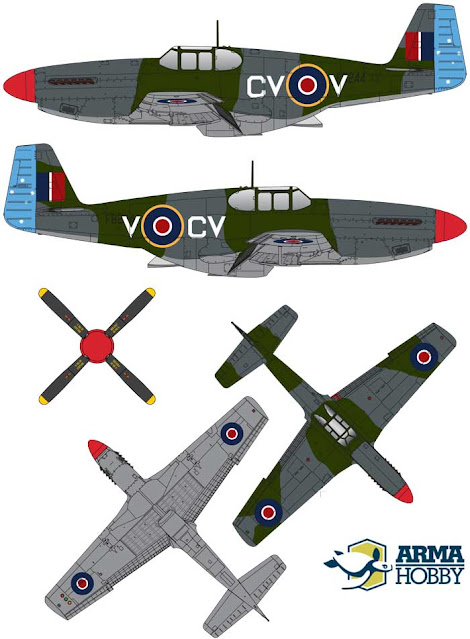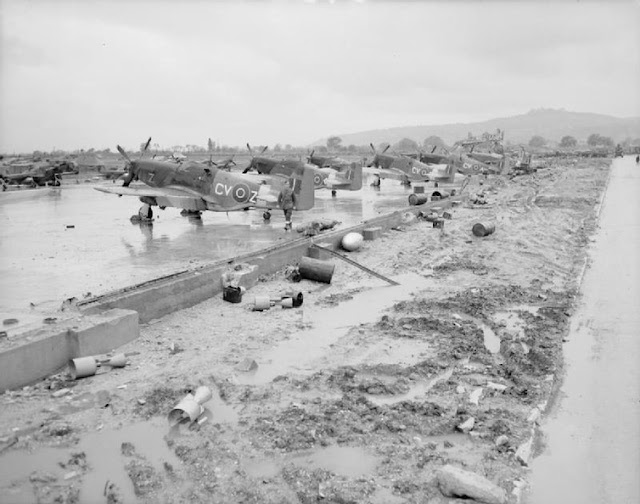P-51B-7-NA s/n 43-6913 “Shangri-La” (KP 1/72)
336th FS, 4th FG, 8th AF, Pilot Capt. Dominic Salvatore “Don" Gentile
Debden Airfield, Essex - England 1944
Capt. Dominic S. “Don” Gentile - 336th FS/4th FG/8th AF - England 1944
Kit: Kovozávody Prostejov - KP #KPM0029 Scale: 1/72
Aftermarket:
- EzLine for the antenna.
- BarracudaCast Item: BR72498 P-51 MustangBlock Tread pattern resin main wheels.
The kit is very good and it was the best P-51B in 1/72nd scale until the release of the Arma Hobby kit. Decals were used a mix of the kit supplied decals and spare parts since the color register from my sample were very off, especially for the Star’n'Bars decals.
Don Gentile was born on December 6, 1920, in Piqua, Ohio. He joined the Royal Canadian Air Force in July 1941, and the British Royal Air Force No 133 Eagle Squadron in 1942. During this time he was credited with the destruction of 2 enemy aircraft in aerial combat. Gentile was commissioned a 2LT in the U.S. Army Air Forces on September 15, 1942, when the Eagle Squadrons were absorbed into the 4th Fighter Group in England. He was assigned to the 336th Fighter Squadron of the 4th FG and managed to destroy another 19.83 enemy aircraft in the air plus 7 more in ground strafing runs before he returned to the United States in May 1944. This gave him 21.83 total air victories during World War II. After participating in War Bond tours, he was assigned as a Test Pilot at Wright Field, Ohio, where he served until April 16, 1946, when he was honorably discharged. Capt Gentile was recalled to active duty on December 6, 1946 and served as a Plans and Training Officer in the Fighter Gunnery Program until September 1948. He attended the Air Tactical School from September 1948 to June 1949, and then received an Air Force Institute of Technology assignment to the University of Maryland to complete his degree. Maj Gentile was killed in the crash of a T-33 Shooting Star on January 28, 1951, near Andrews AFB, Maryland. Gentile Air Force Station in Kettering, Ohio, was named in his honor in 1962.
His 1st (of 2) Distinguished Service Cross Citation reads:
"For extraordinary heroism in action against the enemy, 8 March 1944. On this date Captain Gentile, while leading a section of Fighter aircraft on a bomber escort mission to targets in the vicinity of Berlin, Germany, saw a flight of bombers being attacked by approximately fifty enemy fighters. With only his wing man as support and without regard to the overwhelming odds against him, Captain Gentile immediately attacked the enemy formation and by extremely courageous flying and skilful gunnery destroyed three enemy planes and broke up the threat against the bombers. Continuing with his wing man, they destroyed three more enemy fighters. By this time the wing man had expended his ammunition and Captain Gentile's supply was very low. Despite this fact, they picked up a straggling bomber and escorted it to friendly territory. Captain Gentile's outstanding courage and determination to destroy the enemy on this occasion set an example of heroism which will be an inspiration to the Armed Forces of the United States.”
Modifications to the kit:
- New resin wheels for the Tread Block pattern as seen in the photos.
- Use of spare parts decals to replace out of register colour for the kit supplied decals.
- The antenna mast is indicate4d wrong on the instructions, used the photo reference for the correct type.
- Camouflage colour scheme:
- Gunze Acrylic Drab I (H52) on upper surface.
- Gunze Acrylic Neutral Grey (H53) for underside surfaces.
- Gunze Acrylic White flat (H11) for stripes and spinner tip.
- Gunze Acrylic Shine Red (H23) for spinner bottom and aircraft nose.
Reference photo































































